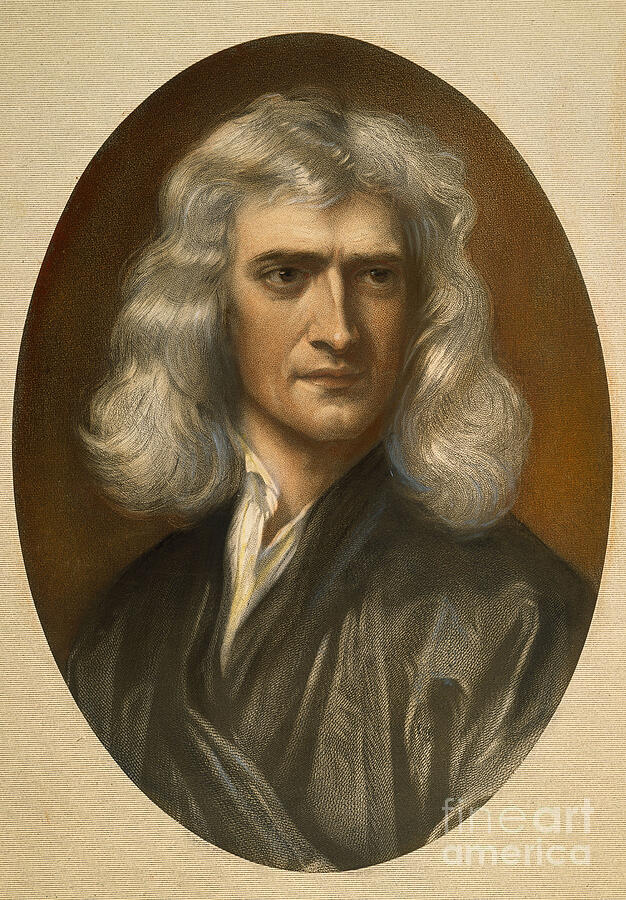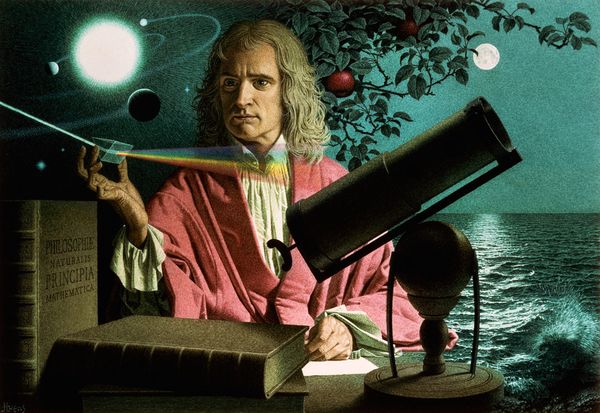

He would spend much of his life at Cambridge, becoming a professor of mathematics and a fellow of the Royal Society (a group of scientists in England). In 1661, Isaac began to attend college at Cambridge. For the rest of his life he would prefer to work and live alone focused on his writing and his studies. At one point his mother tried to take him out of school so he could help on the farm, but Isaac had no interest in becoming a farmer and was soon back at school. Isaac attended school where he was an adequate student. His mother remarried when Isaac was three years old and left young Isaac in the care of his grandparents. His father, a farmer who was also named Isaac Newton, had died three months before his birth.

Isaac Newton was born in Woolsthorpe, England on January 4, 1643. During his lifetime Newton developed the theory of gravity, the laws of motion (which became the basis for physics), a new type of mathematics called calculus, and made breakthroughs in the area of optics such as the reflecting telescope. Even Albert Einstein said that Isaac Newton was the smartest person that ever lived. Isaac Newton is considered one of the most important scientists in history. Three telescopes on La Palma, are called the 'Isaac Newton Group of Telescopes' in his honour.Īs well as options and gravity, Newton developed a maths theory that later became calculus! He also worked for the Royal Mint and worked hard to stop criminals counterfeiting coins.Isaac Newton by Godfrey Kneller Biography: The Institute of Physics awards the 'Isaac Newton Medal and Prize' to a physicist each year. Today, Isaac is still thought of as one of the leading scientists of all time. In 1705, aged 62, he was knighted by Queen Anne and became Sir Isaac Newton. And a change in motion (change in speed) is proportional to the force applied.ģ) For every action, there is an equal and opposite reaction.įollowing the publication of Principia, Isaac became famous. The Principia contain the 3 Laws of Motion:ġ) A stationary body will stay stationary unless an external force is applied to it.Ģ) Force is equal to mass times acceleration. This is still thought to be one of the most important events in the history of science. In 1687, aged 44, he published his work in his most famous piece of writing: the 'Philosophiæ Naturalis Principia Mathematica’ (Mathematical Principles of Natural Philosophy). Isaac's work explained everything from apples falling to the Earth's orbit around the Sun. Isaac built his ideas on the work of Galileo. He developed a theory of gravity based on maths. In any case, the event led him to think about why the apple fell straight down, and not at an angle. It may be more true that Isaac only saw an apple fall. Today this is known as a Newtonian telescope.Īccording to the legend, Isaac was at home during the Great Plague, sitting under a tree when an apple fell and hit him on the head. To solve the problem, Isaac designed the first reflecting telescope. The white light would separate slightly into its spectrum of colours and blur. From this, he worked out that this would cause a problem for refracting telescopes. By using a prism, he discovered that white light is made up of all the colours in the spectrum. Isaac did important work in the area of optics, the science of light. He spent 2 years back at his mother’s home and continued to work on his ideas about maths and the world around him. When he was 22, Isaac’s college closed because of the Great Plague. Isaac worked as a servant to pay his way at college for a few years until he won a scholarship. His uncle had previously studied there and recommended him to the university. At the age of 18, Isaac went to the University of Cambridge. His mother wanted him to be a farmer, but Isaac hated farming.

At school, he learned Latin, Ancient Greek, and some maths. For most of this childhood he was raised by his grandmother and went to a grammar school. Source: Letter from Isaac Newton to Robert Hooke, 5 February 1676. "If I have seen further it is by standing on the shoulders of giants." Research Areas: Optics, maths, motion, gravity Occupation: Mathematician, Astronomer, and Physicist


 0 kommentar(er)
0 kommentar(er)
